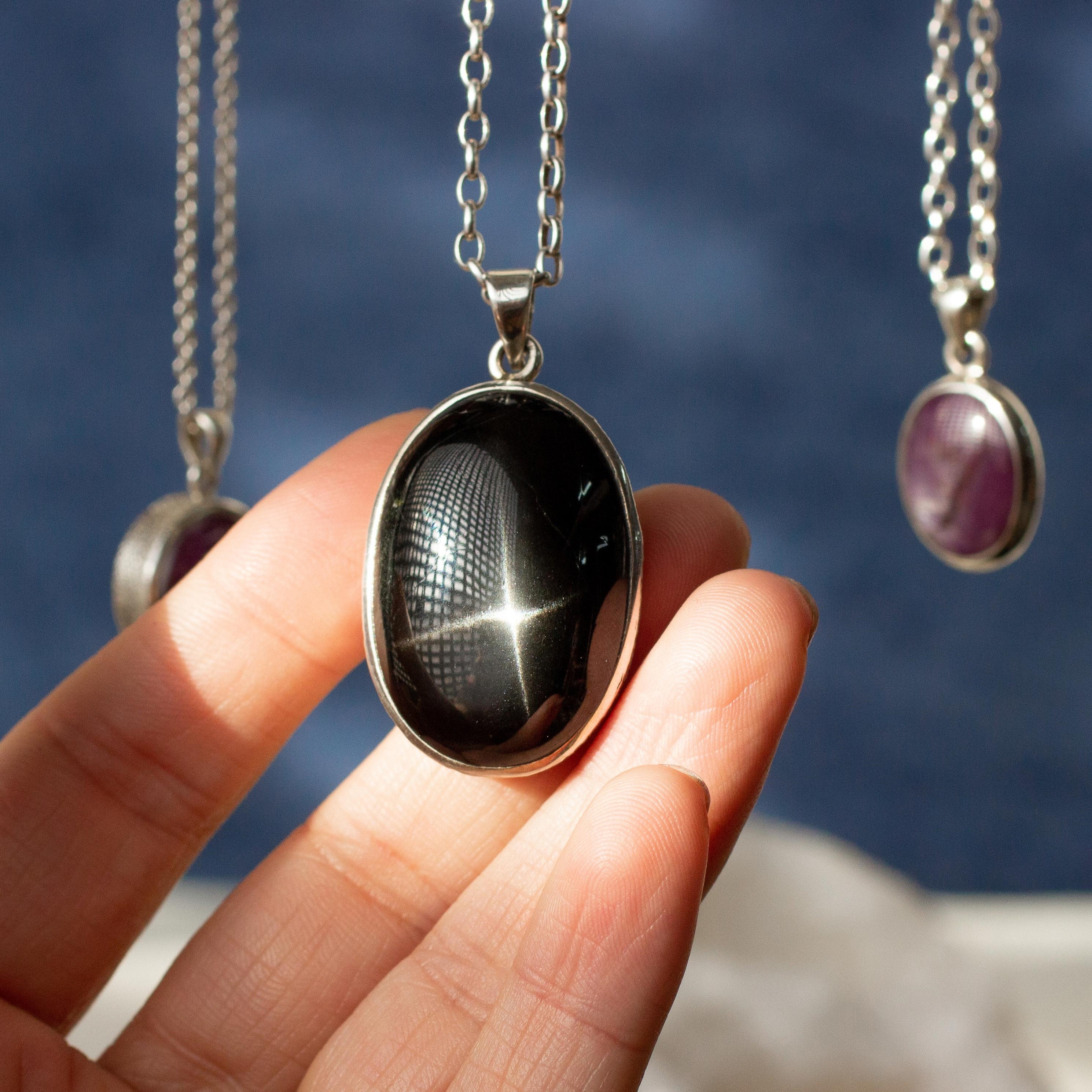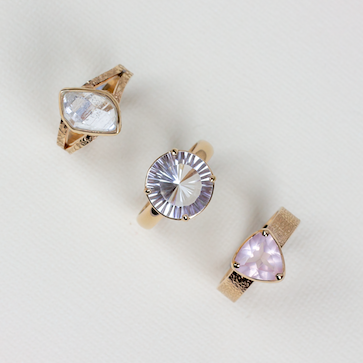It’s hard to stay grounded when you stop and think about the situation we're faced with in this life. We're on a giant ball spinning in space at 1600 kilometres per hour, a few planets away is a gigantic fireball a million times larger than earth AND we're all floating in infinity (whatever that means).
Now bring your thoughts back down to earth and ponder this. Crystals can take thousands to millions of years to form, which means they have been present during key moments in our planet’s evolution- the ice age, dinosaurs, ancient civilisations etc. Some objects on earth didn’t originate here at all- monstrous molten metal meteors have collided with our land, destroying everything in their path leaving behind a massive crater, altering the climate and reshaping the landscape completely. Then we have tektites, the perfect bridge between earth forming minerals and extraterrestrial materials, humble ruminants of meteoric violence.
We have been lucky enough to acquire some of these rare cosmic minerals and skilfully transformed them into exquisite, one-of-a-kind jewellery pieces. Now, you can adorn yourself with the enigmatic essence of the universe, and wear a tangible connection to the cosmos.

Tektites are generally translucent to opaque black, brown, grey, yellow and occasionally green in colour. Their chemical compositions are similar to both granite and impure sandstone (greywacke) or soils of these compositions, being high in silica (68-82%) with 10-14% aluminium oxide and lesser iron, magnesium, calcium, potassium and titanium. A homogenous glass, the name tektite comes from the Greek work ‘tektos’, meaning ‘molten’. This hard, lightweight material has been found in artifacts across the world, jewellery items, totem stones and fashioned into jewellery world / august 2015 arrowheads and small blades by fracturing the surface into curved shapes with a fine edge.
Although small and unassuming, part of a tektite’s mystique is the unknown. The age of formation and constant surface morphology of our planet can make it hard to identify exactly how they got here and when it all took place. The most popular theory on the ‘how’ suggests an extremely massive meteoric impact, splashing the melted ground rock up into the atmosphere before raining back down onto earth. As for ‘when’, there are four major geographically extended deposit sites (strewn fields) where tektites have been discovered, three of which correspond to known source craters: The 11km diameter Bosumtwi Crater in Ghana is linked to the Ivory Coast tektites, the 24km diameter Ries Crater in Germany is the source of the Central European tektites and the 85km diameter Chesapeake Bay impact structure in North America is the source crater of the North American tektites. The Australasian strewn field is left with the absence of a source crater, although it may be covered by dense forest or may not be a typical rounded crater due to a low-angle impact.
Moldavite
Moldavite is one of the better-known tektites, loved for its rich olive green to dull green colour and delicate feathered external texture. Found in Moldau, Czechoslovakia this tektite corresponds to the Ries Crater in Germany where the impact is believed to have been some 15 million years ago. Worshipped for thousands of years for its high-energy vibration and gem-like qualities, it is a beautiful tektite for jewellery.
The majority of Moldavite, remnants of celestial impacts during the middle to Upper Miocene era, lies concealed within Earth's depths, accessible only in select regions near crater sites. The extraction process involves meticulous efforts and extensive measures, contributing to its steep cost. Typically discovered as droplet-shaped particles merely a few centimeters in diameter, Moldavite in its raw form is diminutive, requiring delicate refinement and cutting to transform it into wearable gemstones. Large specimens are exceedingly scarce due to these challenges, amplifying the value of even seemingly modest fragments.
Regrettably, Moldavite's limited supply, coupled with its irreplaceable nature, has propelled its market price to soaring heights, driven further by the demand from those seeking its spiritual healing properties. Consequently, this scarcity has led to the proliferation of counterfeit pieces as unscrupulous individuals strive to replicate the stone's natural allure with deceptive imitations. Bunny Bed, owner and owner of Made In Earth, has felt the brunt of these low cost imposters.
“Large, good quality Moldavite is difficult to find at the best of times and now the market is flooded with imitations. They are sold at very cheap prices and look scarily similar to the real deal. As they have a raw external surface it is hard to examine and test so you really need to know and trust your source. I’ve dealt directly with locals in the Czech Republic for years and prices are going up, not down.”
Libyan Desert Glass
Some 28 million years ago a gigantic extraterrestrial body collided with earth two such materials that so closely resemble at great velocity and landed in the desert in Libya. The heat from the impact melted the sandstone onto which it fell and so the Libyan Desert Glass was created… or so the story goes. Libyan Desert Glass has generated intense interest in scientific communities due to the uncertainty surrounding its origins and has sparked many evolving theories.
Located in the great sand sea on the Egyptian Libyan border, the strewn field spans 128 km north to south and 48 km east to west, in terrain so inaccessible and inhospitable it’s remarkable to have been discovered at all. The mysterious, vitreous substance overlies bedrock of the Nubian Sandstone deposited during the early Cretaceous epoch some 100 million years ago. Known as the stone for leadership and task completion the glass was used for tools by Pleistocene man (11 thousand to 2 million years ago) and may have been discovered in modern times as early as 1846. However it wasn’t until 1934 that modern science had a closer look and the scientific debate on the mystery of its creation began to unfold.
As for the application of this mysterious glass in jewellery, it has in fact been used for centuries. The centrepiece of one of Tutankhamen’s necklaces us a scarab beetle carved out of the lustrous yellow-green glass.
Its origins may continue to intrigue mankind for decades, whether or not its creation was a direct result of an extraterrestrial body colliding with earth. This truly remarkable material has been utilised throughout history and continues to be admired for its beauty and mysterious beginnings.
Meteorites are among some of the oldest and most rare minerals on our earth and have been falling from the sky for eons. Believed to have begun their life as part of the asteroid belt between Mars and Jupiter, meteorites are a natural material that has been knocked out of orbit by colliding with other objects. These pieces of celestial debris plummet towards earth at tremendous speeds reaching up to 28,000 kilometres per hour, transforming into an intense burning meteor, or shooting star, for a short moment in time before colliding with the earth.
Gibeon Meteorite
An important iron meteorite to note is the Gibeon Meteorite from a large region of what is now present day Namibia, Africa. Although it was used by the Nama people of Gibeon for spear points and tools for thousands of years it was first officially reported in 1838 by Captain J.E Alexander who collected samples for analysis which led to the discovery of it’s extraterrestrial nature. By studying the external characteristics and spread of its strewn-field (120 km wide and 390 km long) it is suggested that the Gibeon meteorite was a single large meteorite that burst high in the atmosphere catapulting fragments in all directions.
With chemical constituents of 90% iron 8% nickel. 0.4% cobalt, and 0.04% phosphorus, kamacite, and taenite are the two component iron-nickel alloys that exist within the meteorite’s composition and by studying them the structural classes can be determined. One intriguing phenomena of iron meteorites is an amazing internal structure formed by these two alloys, first described by Count Alois Von Beckh Widmanstätten in the 19th century, as a complex interlocking crystalline pattern and aptly named the Widmanstätten Pattern. Crystallising in an octahedral form the two alloys form a cross-hatching of triangular shapes, which vary depending on the direction the meteorite is cut. In order to reveal this remarkable metallic grid the iron meteorite must be cut into a slab, polished, and etched in a nitric acid solution.
Unique to meteorites, the Widmanstätten pattern is formed by the extremely slow cooling of the molten metal alloys at a rate of approximately 1 degree per thousand years. The presence of these patterns is evidence that the heavy iron material os of extraterrestrial origin, as these conditions cannot be replicated in a laboratory. The Gibeon Meteorite is the perfect example of a fine octahedrite Widmanstätten pattern and although estimated to have collided with the earth’s crust some thirty thousand years ago radiometric dating places the age of crystallisation of the iron-nickel metal at 4 billion years!
Sikhote-Alin Meteorite
Once upon a time, in a land far, far away in the still frosty morning light, the sky came to life with fireballs as bright as the sun. At 10:38am on February 1947 it rained a shower of meteors over the thick forest of the Sikhote-Alin Mountains in Eastern Russia. In the 5 seconds of rapid trajectory the meteorite traveled over 600 kilometre, exploding mid-flight into fragments, finally impacting the earth in a series of explosive bangs followed by a thunderous roar that roared over the hills echoing throughout villages. The enormous meteorite left behind a dusty trail of smoke and meteoroid particles that could be seen in the sky until sunset.
The Sikhote-Alin Meteorite is the largest observed meteorite to have fallen in modern history. It is estimated that over 23,000 kg fell that morning leaving behind 120 craters, the largest measuring 6 x 26 meters, with debris covering an elliptical area of 1.62 kilometres. The pre-atmospheric size of meteorite body was suggested to weigh over 100 tonnes and more than 70 tonnes estimated to have reach the earth’s surface. From this, 8,500 specimens have been collected, the largest weighing in at 1,745kg!
Known as the ‘stone of endurance’ iron meteorites are amongst the densest materials on earth and were once part of the hot core of a long vanished planet. With an iron content over 90% these meteorites are much heavier than any earth rocks.
The universe has always intrigued mankind; its infinite size is more than most of us can comprehend. Occasionally a small fragment of this enormous celestial world zooms into our atmosphere challenging what we know is possible and providing things of beauty truly out of this world.







